
by Rachel Crowell Tuesday, April 10, 2018
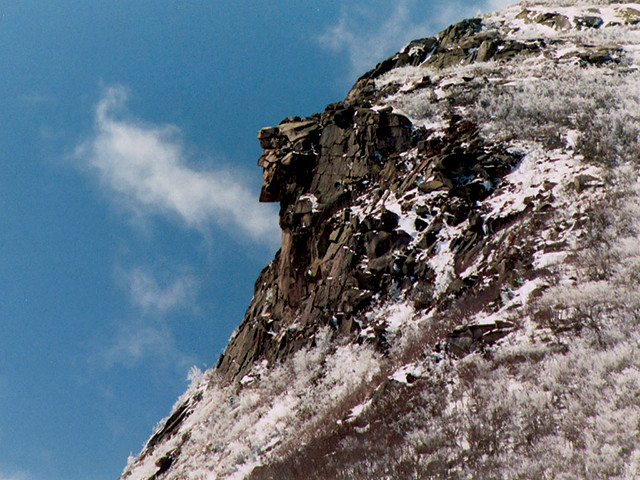
New Hampshire's famed face-shaped outcrop of Conway Granite, known as the Old Man of the Mountain, shown in April 2003. It collapsed one month later. Credit: Jeffrey Joseph, public domain.
On May 2, 2003, the Old Man of the Mountain, New Hampshire’s famous face-shaped granite formation, adorned the side of Cannon Mountain in Franconia Notch State Park, just as it had for millennia. But by the next morning, it was gone: The iconic stone face had fallen.
Even before the formation toppled, many knew that the state emblem, also known as the Profile or the Great Stone Face, would eventually collapse. The blocky outcrop of Jurassic-aged Conway Granite — measuring 13.7 meters tall by 9.1 meters wide and weighing 6,530 metric tons — was perched 370 meters high on a mountainside in a climate where freeze-thaw erosion is common. Still, the news of the Old Man’s collapse came as a shock, even to New Hampshire geologists.
David Wunsch, New Hampshire’s state geologist and director of the New Hampshire Geological Survey at the time, was at home when his phone rang on May 3, 2003. When he saw the call was coming from CBS News, he thought, “Hmm, that’s not good,” he says.
Brian Fowler, an engineering geologist with a long history with the Old Man, also heard about the fall via a phone call: On May 3, Fowler was working in his office when he received a call from a reporter with Manchester’s Union Leader newspaper asking him for his reaction to the collapse, a call he initially thought was a prank. Once he realized it wasn’t, he was “stunned by the news,” he says.
Soon after hearing the news, Wunsch, who is now Delaware state geologist and director of the Delaware Geological Survey, called Fowler to coordinate an immediate trip to survey the damage. Details of the collapse soon emerged. The Great Stone Face was intact when state park employees left work on the evening of May 2, Fowler says. Campers who slept in the state park reported hearing loud noises during that “wet, windy night,” but “the collapse wasn’t identified until about 10:30 the next morning.”
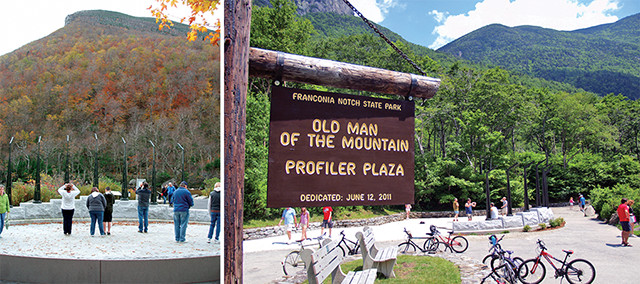
After the collapse, some wanted the icon to be rebuilt, but a state committee decided that rebuilding was not feasible. Instead, a legacy fund was established to build a memorial plaza in Franconia Notch State Park. Credit: both: Old Man of the Mountain Legacy Fund.
Fowler was returning to familiar ground. He had first evaluated the rock mechanics of the Old Man in 1976 while working for the New Hampshire Department of Transportation (NHDOT). He was tasked with determining whether an interstate highway could be built through Franconia Notch without endangering the Old Man. And in the years since, he had worked with the state on preservation efforts. Now, rather than making plans to preserve the Old Man, the goal shifted to deciding how to memorialize it.
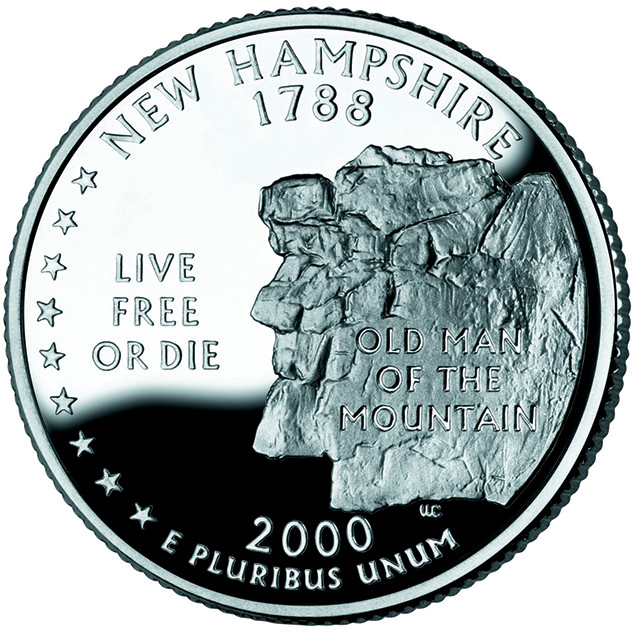
The Old Man of the Mountain continues to be featured on the New Hampshire state quarter, which was first issued in 2000. Credit: public domain.
The realization that, from certain angles, the granite outcrop resembled the profile of a man was first noted by Francis Whitcomb and Luke Brooks in 1805 while they were on a crew surveying Franconia Notch. In 1832, Nathaniel Hawthorne visited the profile, and in 1850 he published “The Great Stone Face,” a short story inspired by the Old Man.
By the mid-20th century, the formation had become a popular tourist destination, and an icon of the state. In 1945, the New Hampshire legislature adopted a state emblem and motto: the likeness of the Old Man surrounded by the phrase Live Free or Die.
But as early as 1872 — when the Appalachian Mountain Club and a Boston newspaper collaborated on a comprehensive article about the Old Man, which included a discussion of its apparently delicate structure — there were concerns about its eventual collapse, according to a 2005 paper by Fowler in the journal Environmental and Engineering Geoscience.
Over the years, many efforts were made to prevent the collapse of the Old Man so that it would live on as a geologic wonder and state symbol, as well as a tourist attraction. Experts and laypeople wanted to preserve the profile, but many also feared that undertaking a major effort to bolster the formation might inadvertently disturb its precariously cantilevered position on the side of Cannon Mountain, causing it to meet an early end.
In 1915, Guy Roberts, a Whitefield, N.H., reverend, persuaded granite quarryman E.H. Geddes to take on the task of “securing the rock mass,” Fowler noted in his paper. The project was approved by local officials, but funded by Roberts and Geddes. The next year, Geddes put the plan into action. By hand, he drilled and installed tie rods into the Great Stone Face’s forehead slab. These rods were placed to maintain the “center of gravity relationships” between different slabs within the profile. Remarkably, the rods remained in place until the Old Man fell.
In 1937, Geddes returned to the Old Man to check on his previous work and “install several additional tie rods, seal over several cracks where water … [seeped] between the slabs and add several poured-in-place cement blocks to provide baselines for detection of incipient movement between the slabs,” Fowler wrote.
The next hardware added to the profile was a collection of turnbuckles installed in 1958 using mechanical drilling equipment. These were added “between the two largest pieces of the forehead slab, to keep the front portion, with its perched crest block, from sliding off the profile,” according to Fowler. Geotechnical monitoring of the Old Man also began with the installation of the turnbuckles, as they were outfitted with strain gauges.
At this stage, however, the preservation attempts were already met with skepticism, wrote historian Frances Ann Johnson Hancock in her 1983 book, “Saving the Great Stone Face: The Chronicle of the Old Man of the Mountain.”
“One newspaper remarked negatively,” Hancock wrote: “‘The rugged profile in Franconia Notch is in danger of coming apart at the seams. If it does, it will come roaring down from the mountain in a 1,200-foot landslide, and all the king’s horses and all the king’s men will never be able to put this Humpty Dumpty back together again.’ Some engineers feared that the work ‘might trigger a sizeable collapse’; others declared that efforts could, at best, ‘be expected to only prolong the life of the Old Man’ whose destruction, they said, would ‘ultimately be inevitable.'”
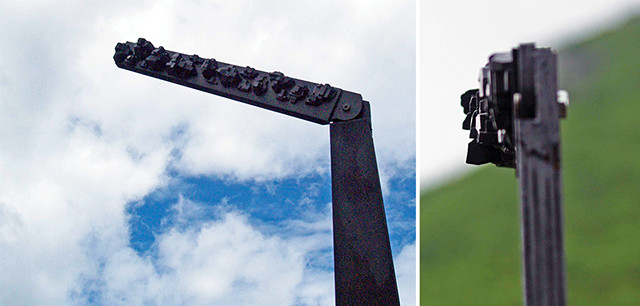
The memorial plaza includes "profilers" that recreate the image of the Old Man in its former location on the side of Cannon Mountain. Credit: both: Old Man of the Mountain Legacy Fund.
Not only was the Old Man still vulnerable, but the quest for answers about the stability of the formation was also incomplete. NHDOT needed to know if an interstate could be built beneath the profile and, if construction proceeded, what steps could be taken to keep the profile safe.
In 1976, Fowler was a 25-year-old early-career geologist when, along with civil engineer Roger Martin, he was tasked with making this determination. “I was told to get up there and get going,” he says. Unlike many others, he didn’t fret about the possibility of accidentally knocking down the Great Stone Face as he conducted the first structural-mechanical analysis of the formation.
“I think I was too young to understand the risk we faced,” he says. He didn’t realize how much his reputation might have been damaged if the Great Stone Face — which rested almost entirely on the chin block, 80 percent of which was cantilevered out over the edge of the cliff — had fallen on his watch. His lack of concern “was kind of a mixed blessing,” he says. A lifelong rock climber, he was just thrilled to be “getting paid to rock climb all summer.”
Fortunately, he and Martin were able to use rock climbing techniques, modern for the time, to safely climb down the Old Man’s face. Using photogrammetry, they determined that highway construction could proceed without harming the Old Man, if vibrations from blasting were kept to a minimum near the profile. By 1986, the interstate was completed without damage to the Old Man.
“It was a pretty clear May day when the Old Man was discovered fallen,” Wunsch says. The road to the site where the Old Man once perched was closed by a state trooper. “I pulled over to one of the viewing spots and looked up, just to see how much of the Old Man did indeed fall. I could only see the straggly remains of the steel turnbuckles,” he says.
“The intricate profile resulted from chemical weathering and freeze-thaw rockfalls from the glacially eroded face of Profile Mountain,” Wunsch and Fowler noted in a 2004 Geotimes article. “These same processes were also responsible for its ultimate demise,” they added.
Demise might be an unusual way to describe an erosional process, but the formation was much more than a cluster of rocks to many New Hampshire residents. “The oldest member of my family just died,” a tearful David Nielsen said in the aftermath of the collapse. David’s father, Niels Nielsen, began maintaining the outcrop in 1958 when he was a bridge engineer for NHDOT. In 1980, David began helping his father, who, 10 years later, was appointed by the governor as the first official caretaker of the Old Man, a role David later also held. Year after year, Niels and other family members had returned to repair an epoxy seal that Niels originally placed in 1972 to prevent cracks caused by freeze-thaw cycles from destabilizing the Old Man.
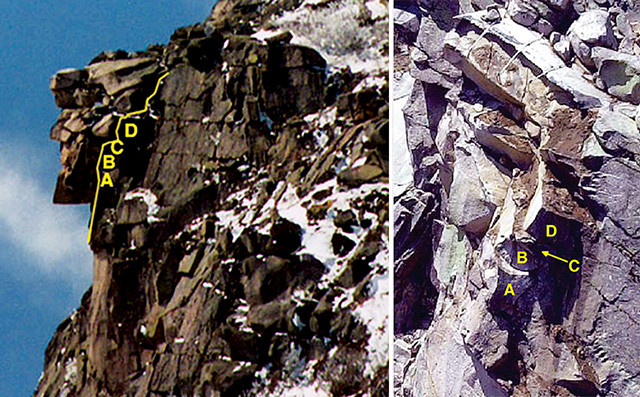
The annotated photo at left shows the line along which the outcrop that had formed the Old Man of the Mountain failed. The photo at right shows the remaining surface with blocks labeled. Credit: left: K. Cantner, AGI, after Fowler, Environmental and Engineering Geoscience, 2005; right: Union Leader Corp., 2003.
While the scene of the fallen Old Man brought Fowler to tears on his drive home that day, understanding how the formation failed helped him finally answer a long-held question: Was there anything more he could have done to prevent its ultimate failure? In his analysis that preceded the construction of the interstate through Franconia Notch, he had not been able to use a technique that was in its infancy in the 1970s: finite element analysis. He had long wondered whether the technique might have offered insight that would have helped to preserve the Old Man. “In retrospect, now that we know the mechanics of how it failed, we pretty well know there wasn’t much that could have been done” at the time to prevent the failure, he says.
“Had the Old Man been able to survive another decade or so,” Wunsch notes, it might have been possible to use lidar-based techniques to try to save the formation. A lidar map could have made it possible to fit the profile with an unobtrusive metal mask bolted to the surrounding rock, he adds. Wunsch was a technical consultant for the Old Man Restoration Task Force, the governor-appointed body charged with determining how to memorialize the Old Man. Although some wanted to rebuild the natural wonder, arguments against it included the instability of the remaining rock mass, the risk to restorers and the potential for environmental damage.
The task force disbanded and the Old Man of the Mountain Legacy Fund, of which Fowler is now president, took over the project of memorializing the Old Man. Today, visitors are greeted by a plaza, where, by looking through a profiler suited to their height, they can experience an optical illusion that the Old Man is back on the mountain, where it had long stood the test of time.
© 2008-2021. All rights reserved. Any copying, redistribution or retransmission of any of the contents of this service without the expressed written permission of the American Geosciences Institute is expressly prohibited. Click here for all copyright requests.